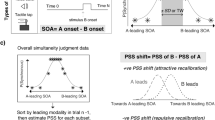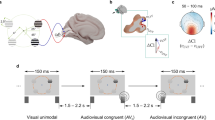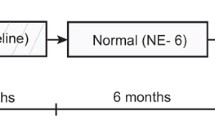Abstract
Animal studies have shown that visual deprivation during the first months of life permanently impairs the interactions between sensory systems. Here we report an analogous effect for humans who had been deprived of pattern vision for at least the first five months of their life as a result of congenital binocular cataracts. These patients showed reduced audio-visual interactions in later life, although their visual performance in control tasks was unimpaired. Thus, adequate (multisensory) input during the first months of life seems to be a prerequisite in humans, as well as in animals, for the full development of cross-modal interactions.


Similar content being viewed by others
References
Lewkowicz, D.J. & Lickliter, R. (eds.). The Development of Intersensory Perception: Comparative Perspectives (Lawrence Erlbaum Associates, Hillsdale, New Jersey, 1994).
Wallace, M.T. & Stein, B.E. J. Neurosci. 17, 2429–2444 (1997).
Wallace, M.T. Cogn. Process. 5, 69–83 (2004).
Wallace, M.T. & Stein, B.E. J. Neurophysiol. 97, 921–926 (2007).
Hötting, K., Rösler, F. & Röder, B. Exp. Brain Res. 159, 370–381 (2004).
Röder, B., Rösler, F. & Spence, C. Curr. Biol. 14, 121–124 (2004).
Wallace, M.T., Perrault, T.J., Jr., Hairston, W.D. & Stein, B.E. J. Neurosci. 24, 9580–9584 (2004).
Carlson, S., Pertovaara, A. & Tanila, H. Brain Res. 430, 101–111 (1987).
Le Grand, R., Mondloch, C.J., Maurer, D. & Brent, H.P. Nature 410, 890 (2001).
Maurer, D., Lewis, T.L., Brent, H.P. & Levin, A.V. Science 286, 108–110 (1999).
Ghazanfar, A.A., Maier, J.X., Hoffman, K.L. & Logothetis, N.K. J. Neurosci. 25, 5004–5012 (2005).
Ellemberg, D., Lewis, T.L., Maurer, D., Lui, C.H. & Brent, H.P. Vision Res. 39, 3480–3489 (1999).
Ernst, M.O. & Banks, M.S. Nature 415, 429–433 (2002).
Röder, B., Kusmierek, A., Spence, C. & Schicke, T. Proc. Natl. Acad. Sci. USA 104, 4753–4758 (2007).
Acknowledgements
We are grateful to all participants; many of the individuals put in a great deal of effort to participate. We thank the Deutsche Blindenstudienanstalt Marburg, the Department of Ophthalmology at the University Hospitals Giessen and Marburg (P. Kroll) and Hamburg (G. Richard), the Westfälisches Berufskolleg fuer Blinde und Sehbehinderte Soest, and the Department of Pediatric Ophthalmology, Strabismology and Ophthalmogenetics at the University of Regensburg (B. Lorenz) for their support in recruiting participants. We thank K. Hoetting for providing the control data for Experiment 3, J. Gläscher for programming support for Experiment 2, and C. Büchel for early comments on Experiment 2. This study was supported by grants from the German Research Foundation (DFG; Ro 1226/4-2 and 4-3) to B.R.
Author information
Authors and Affiliations
Contributions
L.P. and B.R. designed the research and K.L. contributed a major research idea. L.P. and I.G. carried out the research, L.P. and B.R. analyzed the data and L.P., B.R. and F.R. wrote the paper.
Corresponding author
Supplementary information
Supplementary Text and Figures
Supplementary Table 1, Methods, Note (PDF 677 kb)
Rights and permissions
About this article
Cite this article
Putzar, L., Goerendt, I., Lange, K. et al. Early visual deprivation impairs multisensory interactions in humans. Nat Neurosci 10, 1243–1245 (2007). https://doi.org/10.1038/nn1978
Received:
Accepted:
Published:
Issue Date:
DOI: https://doi.org/10.1038/nn1978
- Springer Nature America, Inc.
This article is cited by
-
Sound suppresses earliest visual cortical processing after sight recovery in congenitally blind humans
Communications Biology (2024)
-
Study of extravisual resting-state networks in pituitary adenoma patients with vision restoration
BMC Neuroscience (2022)
-
Multisensory integration in humans with spinal cord injury
Scientific Reports (2022)
-
The size-weight illusion is unimpaired in individuals with a history of congenital visual deprivation
Scientific Reports (2021)
-
The normal environment delays the development of multisensory integration
Scientific Reports (2017)





